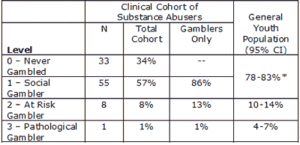Evidence suggests that various groups (i.e., substance users, youth, criminals, psychiatric comorbidity) are at increased risk of developing gambling problems. Whether individuals belonging to multiple risk groups are even more susceptible to gambling problems is unknown. WAGER 7(1) tackled this question by examining a study of criminal youth that found they did not consistently exceed non-criminal youths in their gambling behaviors. This week, we return to the question of additive risk and discuss a study of problem gambling behavior in a cohort of adolescent substance abusers (Kaminer, Burlesibm, & Jadamec, 2002).
Kaminer et al. recruited 97 youths (64 male) aged 13 to 18; these young people were consecutively entering outpatient treatment sessions for psychoactive substance use disorders (PSUD). The authors note that most youths also were diagnosed with one or more psychiatric disorders on Axis I and II. Participants completed the Diagnostic Interview Schedule for Children (DISC-C, Fisher et al., 1993); the Structured Clinical Interview for DSM-IV (SCID-II, First, Spitzer, Gibbon, & Williams, 1995); the Massachusetts Gambling Screen (MAGS, H. Shaffer, LaBrie, Scanlan, & Cummings, 1994); and the Teen Addiction Severity Index (T-ASI, Kaminer, Bukstein, & Tarter, 1991).
The results in Table 1 show that youth diagnosed with PSUD did not have a significantly higher prevalence of gambling problems than the general youth population. Shaffer and Hall (1996) had previously estimated that 4.4% to 7.4% of adolescents experience serious problems with gambling. Kaminer et al. found only one participant who met the criteria for pathological gambling in this study (1%). From this data, the authors concluded that the prevalence of “Level 3 was significantly lower among this cohort relative to the meta-analysis”(p. 197) by Shaffer and Hall.
Table 1. Gambling Level in Clinical Cohort of Substance Users (Kaminer et al., 2002) and in the General Youth Population (H. J. Shaffer & Hall, 1996)

*The meta-analysis did not make a distinction between Levels 0 and 1
Although this conclusion seems correct at first glance, actually, it technically is incorrect. The prevalence of Level 3 gamblers in this study is not statistically significantly lower than the meta-analysis. Simply stated, Kaminer et al. enrolled relatively few subjects (64 gamblers) and the findings are therefore susceptible to chance. Statistically speaking, from the Kaminer data we can be 95% confident that the prevalence of Level 3 gambling in the total population of adolescent gamblers to which Kaminer’s subjects belong is within the interval from .03% to 8.4% (For a discussion of the confidence interval see Wager 7(51) and the glossary). This confidence interval includes the range estimated by the meta-analysis (4-7%). Therefore, the Kaminer et al. data actually fails to support the stated original hypothesis that youth with PSUD would manifest a higher prevalence of pathological gambling; the study outcomes also cannot support the conclusion that this group has a lower prevalence than the general youth population. The limited statistical power to find differences between groups associated with this small sample restricts this study and highlights the need for large sample or metaanalytical studies.
Also, most participants in the Kaminer et al. study were diagnosed with some psychiatric disorder in addition to PSUD. While the association between disordered gambling and psychiatric comorbidity is still under investigation, early evidence suggests these conditions often co-occur (Shaffer & Korn, 2002). Consequently, researchers should not ignore this potentially influential factor when trying to tease out the complex interactions among substance use disorders, youth and gambling behavior.
Despite the statistical concerns described above, this study calls attention to important research aims in the field of gambling behavior. Identifying vulnerable groups, and in this case even sub-groups, that might be at increased risk for gambling problems allows clinicians to design interventions and treatments that specifically target these population segments. In addition, this research suggests that patients with comorbid problems might require a new level of communication and cooperation between among service providers, such as substance abuse and gambling treatment professionals.
Comments on this article can be addressed to Rachel Kidman
References
First, M., Spitzer, R., Gibbon, M., & Williams, J. (1995). The Structured Clinical Interview for DSM-III-R Personality Disorders (SCID-II). J Pers Disord, 9, 83
91.
Fisher, P., Shaffer, D., Piacentini, J., Lapkin, J., Kanfantaris, V., Leonardo, H., et al. (1993). Sensitivity of the Diagnostic Interview Schedule for Children, 2nd Edition (DISC-2.1) for specific diagnoses in children and adolescents. J Am Acad Child Adolesc Psychiatry, 32, 666-673.
Kaminer, Y., Bukstein, O., & Tarter, T. (1991). The Teen Addiction Severity Index: Rationale and Reliability. Int J Addict, 26, 219-226.
Kaminer, Y., Burlesibm, J. A., & Jadamec, A. (2002). Gambling Behavior in Adolescent Substance Abuse. Substance Abuse, 23(3), 191-198.
Shaffer, H., LaBrie, R., Scanlan, K. M., & Cummings, T. N. (1994). Pathological Gambling Among Adolescents: Massachusetts Adolescent Gambling Screen (MAGS). Journal of Gambling Studies, 10, 339-362.
Shaffer, H. J., & Hall, M. N. (1996). Estimating the prevalence of adolescent gambling disorders: a quantitative synthesis and guide toward standard gambling nomenclature. Journal of Gambling Studies, 12(2), 193-214.
Shaffer, H. J., & Korn, D. A. (2002). Gambling and related mental disorders: a public health analysis. In Annual Review of Public Health (Vol. 23, pp. 171-212). Palo Alto: Annual Reviews, Inc.




